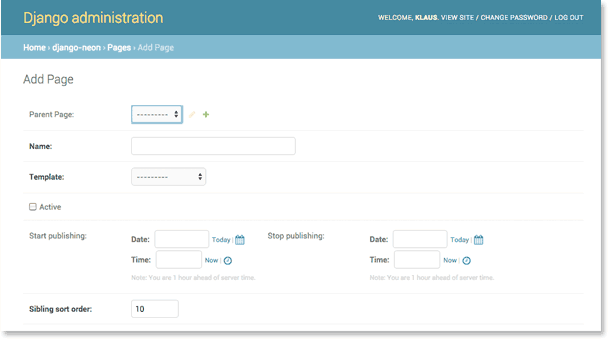Pages
Pages are used for a hierarchical structure of a website. Hierarchical pages build trees and it is possible to have more than one tree and multiple root-pages in a django_neon-application.

The above figure shows five pages with two roots. A page without a parent is a root-page. Pages pointing to a parent-page are children of this page. A page knows about its parent and a parent knows about all children.
Note: Pages don't hold content but build the structure. Refer for Panes about content.
Pages can be added from the admin backend with the following attributes:

- Parent Page:
- Choose the parent page from a list of already existing pages. This is optional. Without a parent page the new page is a root page.
- Name:
- The name of the page, used for navigation.
- Template:
- The template to use. A page must have a template for rendering. See Configuration on how to register templates.
- Active:
- Only active pages will be published. Default value is
False. - Accept Subpages:
- If this flag is set, this page will be selectable as Parent-Page. Consider a Website with lots of pages, mostly leafs and only a few nodes: Unsetting this flag can keep the Parent-Page select-list short. Default value is
True. - Start publishing:
- This value is optional. If given the page will not get published before this date.
- Stop publishing:
- This value is optional. If given the page will not get published after this date.
- Sibling sort order:
- If multiple pages pointing to the same parent-page, then the children get sorted by the
sibling_id, i.e. for building submenus. Pages with lower ids came first.
Pages are only published if marked as Active and the current date is inside the publishing range (Start / Stop publishing) if these ranges are set.
Unpublished pages will not get listed in navigation lists (See Templates about navigation lists).
Calling the URL of an unpublished page will raise a 404 Error.